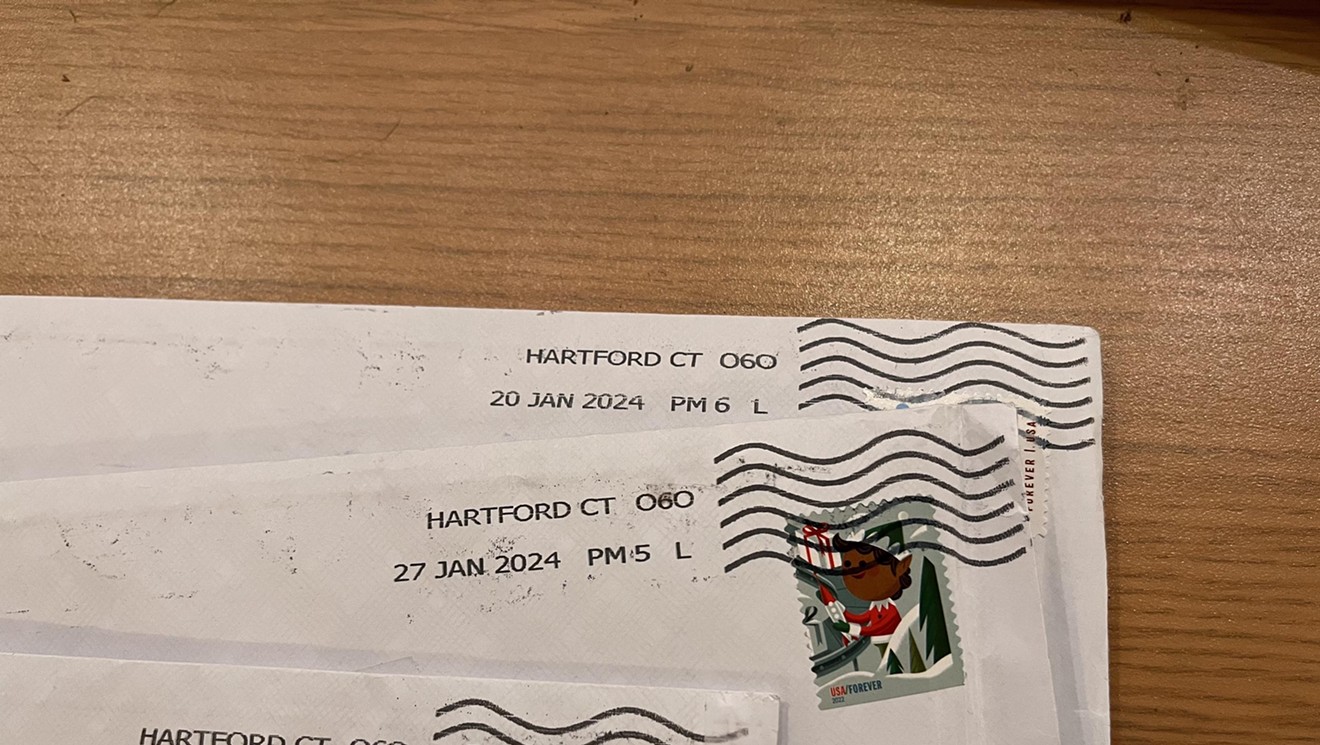Connecticut
2022 was the deadliest year for car crashes in Connecticut

An estimated 368 people died in car crashes in Connecticut in 2022, the first time the state has recorded an average of more than one traffic fatality per day.
But despite being the deadliest year on record, the total number of car crashes remained below pre-pandemic levels, according to data compiled by the Connecticut Transportation Safety Research Center at the University of Connecticut.
So there are fewer crashes on the road, but they’re deadlier.
“The improvements in the work that we’re doing has made our roadways safer, trying to improve our infrastructure. So the conditions haven’t gotten worse. It’s really the driver behavior. That’s changed,” explained Josh Morgan, spokesperson for the state’s Department of Transportation. “There’s a lot of discussion in the DOT circles about road rage, aggressive driving, lack of patience, people being frustrated, a lot of that which bubbled up during the pandemic, playing itself out onto the roadway, taking risky behaviors.”
And while fatal crashes have made up less than 1% of total crashes each year, they still took the lives of more than 2,300 people since 2015. Many of them were DUI-involved crashes, wrong-way crashes, or caused by distractions, among other reasons.
And it’s not just Connecticut — 23 states were projected to see an increase in fatalities in 2022, according to the National Highway Traffic Safety Administration, although counts are not final due to a lag and complexity in data gathering. More complete data is available for 2021, which showed that Connecticut ranked seventh in the nation for its share of traffic fatalities related to alcohol-impaired driving.
The issue dominated headlines weeks ago when a Hartford police officer was killed after a driver sped through red lights and crashed into the officer’s car. But the state legislature has been working on solutions since early this year.
Under the influence and fatalities
Eighty people killed in crashes in 2022 — including drivers, pedestrians and passengers — were under the influence of drugs, alcohol or any other medication last year, accounting for 22.7% of car crash fatalities, compared to 15.7% in 2015.
Drivers under the influence accounted for 19% of all people who died in car crashes, up from 13.4% in 2015.
“It’s really simple. Don’t drive impaired. It’s too often a game of chance, where people will say, ‘I’m fine. I’ll get home safely. I do this all the time.’ That’s just really selfish and reckless behavior,” said Morgan, DOT’s spokesperson.
Another issue on the mind of policymakers is wrong-way crashes. State Rep. Quentin “Q” Williams died in January when his vehicle collided with a wrong-way driver’s.
The annual count for total number of crashes where the vehicle was driving the wrong way or on the wrong side hasn’t dropped below 400 in any year. They had been decreasing every year since 2015 but shot back up in 2021 and last year.
As for fatal wrong-way crashes, there were 15 last year, the highest since 2016, while other years haven’t seen any fewer than seven.
Notably, the number of crashes that were both wrong-way or wrong-side and where a driver was driving under the influence also hit an all-time high of 112 last year, making up about a fifth of all wrong-way crashes. And of those crashes, close to 9% were fatal last year, compared to a low of 2-3% in 2015, 2020 and 2021. The total number of fatal crashes that were wrong-way and DUI-related hit 10 last year.
“The wrong-way crashes we saw in 2022 were a symptom of the impaired driving issue that we have … The BAC for most of those roadway drivers was above a 0.2%, so most of them were well over twice the legal limit,” Jackson said.
Legislative priorities
One bill that became law this year operates on several fronts. It will have the DOT research the idea of prohibiting right turns at red lights and present its findings to legislators and make recommendations. It will also require a person to watch a safety video every time they get their driver’s license renewed; it will create public awareness campaigns to promote safe driving; and it will allow municipalities to opt-in to implement automated speed and red light cameras. Those ideas came from the Vision Zero Council, a workgroup from members of various state agencies including the Department of Transportation, State Police and Department of Public Health, among others, who develop policy-based solutions regarding road safety.
“Unfortunately, the only thing that we really know that works is more enforcement. We’re seeing that with the speed cameras that are being set up in work zones. That as more and more people start getting morning tickets in the mail, we’re seeing an improvement in behavior as people drive through work zones,” said Eric Jackson, the Executive Director of the Connecticut Transportation Institute and the Director of the Connecticut Transportation Safety Research Center at the University of Connecticut.
“The issue we’re facing right now is we have fewer police officers and fewer law enforcement that are able to go out and do that … high-visibility enforcement. So the next logical step is to automate that enforcement. And I know it’s not a popular topic. Most citizens don’t want … to get a ticket in the mail with a picture of themselves. But if we can’t change driver behavior and other ways, this is really, truly going to be the way of the future,” said Jackson.
The legislature also failed to advance a bill that would have lowered the legal blood alcohol concentration limit to 0.05% from 0.08%, despite support from the state’s DOT. Only Utah has the 0.05% limit as law, and a study of the state’s crash data shows that 12 months after the law went into effect, the rate of crashes per vehicle miles traveled involving at least one person who tested positive for alcohol dropped by 8.9%.
In 2020, Connecticut was the third-worst state in the country when it came to the percentage of traffic fatalities linked to drunken drivers, according to Department of Transportation Commissioner Garrett Eucalitto.
A new law that went into effect Oct. 1 also operates on several fronts. Besides expanding public awareness, it will expand the DOT’s efforts to install wrong-way detection systems on exit ramps that are determined to be high-risk. The detection system flashes lights at a driver to notify them that they are going in the wrong direction. Seventeen ramps already have the technology with a requirement of 128 as part of the new law. The bill also requires additional technology to be implemented at the exit ramps that will alert law enforcement if a vehicle is determined to be driving the wrong way.
The bill also establishes a pilot program that will look into broadcasting a warning about a wrong-way driver to other drivers on electronic boards along the roads, and the University of Connecticut is also set to receive funding to test rumble strips, which would alert drivers that they’re driving the wrong way through vibrations and sounds created by the strips on the road.
Deeper analyses of the crash data compiled by the Connecticut Transportation Safety Research Center shows that of the thousands of fatalities since 2015, 65% of them were the driver, 19% were pedestrians and about 13% were passengers.
As for age groups, the highest-hit was the 18-34 year old group at 893 deaths since 2015, making up 35% of the total. The 35-49 and 50-64 groups each made up a fifth of the total.
Most of the crashes are happening in largely populated cities such as New Haven, Bridgeport and Hartford. But 47 towns had more crashes in 2022 than in 2015.
In Plainfield, there were 300 crashes last year compared to a low of 191 in seven years ago, a 57% increase. In Norwalk, crashes have consistently been above 3,400 each year, with 2020 as an exception and compared to a low of 2,565 in 2015.
As for time of day, the period between 3 p.m. and 5 p.m. had the most crashes, making up a quarter of all crashes since 2015. More crashes happen on Fridays — 16.8% — compared to a low of 10.9% on Sundays.

Connecticut
IHOP Plans To Open New Location In Connecticut: CT News

Patch PM CT brings you the breaking and trending news stories from all across Connecticut each weeknight. Here are those stories:
While other chain restaurants are shuttering locations, at least one has plans to open a restaurant in Connecticut.>>>Read More.
Police said they are investigating after a Jeep crashed into a dance school.>>>Read More.
A man’s family was awarded $15 million in a lawsuit claiming he contracted cancer due to asbestos exposure, according to a report.>>>Read More.
A man struck it rich playing blackjack at the casino recently.>>>Read More.
Several handguns were stolen, with the getaway vehicle being in a nearby town.>>>Read More.
A 25,000-square-foot inflatable playground, will be back starting Memorial Day Weekend.>>>Read More.
Other top stories:
The Patch community platform serves communities all across Connecticut in Fairfield, New Haven, Middlesex, New London, Hartford, Tolland, and Litchfield counties. Thank you for reading.
Connecticut
Flying Bed Cover Causes Crash On Highway In Northern Connecticut

UNION, CT — A flying piece of bed linen made for a restless night for one driver on a stretch of highway in northern Connecticut over the weekend.
According to a state police crash report, a 2003 Toyota Camry with a 54-year-old Lowell, MA, man behind the wheel was headed east near Exit 72 in Vernon at 12:18 p.m.Saturday. What was described by troopers as a “bed cover” flew off a pickup truck just ahead of the Camry and landed on it, according to a crash report.
It blocked the driver’s view and the car crashed, state police said.
No injuries were reported.
Connecticut
Opinion: CT has stupid high property taxes; a case for regional government

Each year, towns in Connecticut go through the painful budget process, and my town of South Windsor is no different. What is different is how politically charged this has become.
The basis of the politicalization seems to be rooted in “the tax issue.” This past year South Windsor went through the real estate re-evaluation process required by law every five years. With the rise in real estate values, those evaluations increased dramatically.
The good news; your house is worth more. The bad news; your tax burden is going up.
This did not sit well with many residents. So, in November, the town voted out our super-majority Democrat Party Town Council and voted in a super-majority Republican Party Town Council. The Republicans had campaigned on a platform of cutting taxes, which obviously appealed to many voters.
It waits to be seen whether new town leadership can hold the line on taxes without negatively impacting our schools, town services, head count, and more. This is not a partisan issue. The dread of higher taxes is not a Republican or a Democratic thing. I view it as a practical thing.
Let me explain. I moved to Connecticut in 2002 having lived most of my life in Maryland and Pennsylvania. I learned quickly after moving here that property taxes in Connecticut were not just high, they’re stupid high. And on top of that I had to pay a tax because I own a car. I’ve never paid a personal property tax in my life previously.
Why is this? It’s simple math – towns need revenue to support expenditures. The revenue side is static. Connecticut does not have a prolific tax base. There is no Boston generating billions in tax revenue. Our statewide population is that of a Minneapolis or Tampa. We are not getting a windfall. So practically speaking, the only place to adjust is on the expense side. And here we have a wonderful opportunity.
That opportunity is called, regional government. It is a state-wide solution. This state is a victim of an incredibly inefficient provincial system of government that goes back to colonial days. We have 169 little kingdoms each duplicating the costs of each other. This creates an insane level of cost redundancy. We operate in fiscal silos with few or no economies of scale.
And you know who agrees with this? Forty-eight other states, none of whom do government this way; only Connecticut and Rhode Island operate in this manner. Think about that enormous duplication of costs across; parks and rec, public works, elderly services, tax collection, legal advisers, economic development, health services, IT infrastructure and education, just to name a few budget line items that could be streamlined.
Back in the 60s and 70s there was an attempt to move to regional government but it was so poorly executed that it failed. The infrastructure already exists as we have counties and planning groups called Regional Councils of Government. For this massive change to occur we need the will of leaders. But the grassroots level is where it needs to start as elected officials will not want to cede power.
Voters have to assert their will.
This is not a solution for today. It would take years if not decades to get to regional government. But 48 states have proven it works. If we’re serious about reducing taxes this is one big swing of the bat can get us there. For young families planning a long-term future in Connecticut, this would benefit kitchen table issues. If we start now, maybe your kids won’t have to pay a tax to own a car.
Paul Bernstein is a retired marketing executive who lives in South Windsor.
-

 News1 week ago
News1 week agoSkeletal remains found almost 40 years ago identified as woman who disappeared in 1968
-

 Movie Reviews1 week ago
Movie Reviews1 week ago“Kingdom of the Planet of the Apes”: Disney's New Kingdom is Far From Magical (Movie Review)
-

 World1 week ago
World1 week agoIndia Lok Sabha election 2024 Phase 4: Who votes and what’s at stake?
-

 World1 week ago
World1 week agoUkraine’s military chief admits ‘difficult situation’ in Kharkiv region
-

 Politics1 week ago
Politics1 week agoTales from the trail: The blue states Trump eyes to turn red in November
-

 World1 week ago
World1 week agoBorrell: Spain, Ireland and others could recognise Palestine on 21 May
-

 World1 week ago
World1 week agoCatalans vote in crucial regional election for the separatist movement
-

 Politics1 week ago
Politics1 week agoNorth Dakota gov, former presidential candidate Doug Burgum front and center at Trump New Jersey rally
















